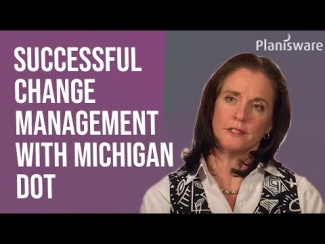X
My name is Diane East and I'm a DOT project manager, and I work for Xriver Technologies.
Could you please describe your company? (0:12 to 0:38)
Xriver is a small, integration systems company since 1984 and they've been building different kinds of project management systems. Some of them have been outside-the-box and some of them have been out-of-the-box. We've been a Planisware partner since 1999 when they first came to the United States and we're basically working on our second DOT, but we've also worked in pharma and a number of different industries doing Planisware implementations, so that's the role we function in.
Please summarize your DOT experience. (0:40 to 0:54)
Over the past 22 years, I've worked with 10 different DOTs in the process of either planning, implementing or post-implementation support of project management systems.
What are the key challenges to implementing successful change management in an organization? (0:56 to 01:28)
I would say a lot of people underestimate how important change management is, but it is a very, very important element. A lot of users simply won't adopt a system. They'll keep doing things the way they're used to. And depending on the silos within your organization, that can kill a new system, or at least create a lot of backwater, if you will, that you have to fight through. And it's really not something that has to be done if you use a proactive approach and you teach users how it will benefit them and how it will impact them, they will embrace it. They will move forward.
How did you approach change management for Michigan DOT? (01:32 to 02:52)
What was really the biggest coup on this particular implementation was the change management aspect of it. We not only got, identified the greatest superusers in the world, but they were with us from the very beginning. They helped us with the requirements, we brought them in for user testing and at user testing, we started dreaming about what we would be doing with the training implementation. From that point, we organized the train the trainer sessions. We got all of those people in, we made little badges for them, they came up with the slogan "agent of change" and those users basically went out with their agent of change badges throughout the organization.
Following that, we ended up doing webinars and we ended up reaching close to 300 people through the webinars. Again, the superagents went out there and they went and generated the interest in the webinars and got them through it. The webinars' purpose was just to familiarize them with the interface. So, when they walked into training, they weren't learning what color is it and how do you get around, where's the tabs. They were ready for the interface and we were also able to teach them how it was going to impact their job and possibly incentivize them to attend the end-user training. So, it was basically a multi-step process over several months, but we had a great, crackerjack team and we just kind of spread it on through.
Did the change management plan impact user adoption? (02:54 to 03:22)
I think that not only were they ready to let go of this old, antiquated system that they had, but it also … the awareness was there. And people were ready. And the superusers, after they sat with it for two weeks and we did our train the trainer sessions, they were saying, "this interface is so great" and that's the music, if you will, that they were making when they got back to their regional offices. And that helps a lot as a groundswell, especially in a structured environment like state government.
At what point in the process did you implement the change management plan? (03:24 to 03:59)
It wasn't a big part of the scope of work, but it is one of my passions. And as one of my passions, it's not enough to throw an application on a user's desk. You have to teach them why they need it and you have to give them the tools in order to use it. So, as we approached training, I kept saying, "we've got to do this." I really want Michigan to turn around and say incredibly wonderful things about Planisware and about XRiver, so how do I do that? So, I started talking to them about that groundswell, those change agents, about getting things moving in a very positive direction from the beginning and throughout the implementation.
What advice would you give to an organization new to change management? (04:02 to 04:53)
I guess the key word is don't underestimate the importance of change management and the second key word is communication. You have to reach out often and with various messages so that people understand what's coming, how it impacts them, how you use it, and you need to give them the tools in order to use it at the right time.
I think change agents is another very important thing about change management. Those are people that basically need to be infiltrated within your organization at every level, at every location. They become people that other users can go to. You can basically say, "I have a question, I can't figure this out, but I'm not going to call somebody, but I know so-and-so down the hall and I bet they can help me with that." And those superusers simply become mega-superusers as they help other people do it, and it goes from there. Good stuff.
